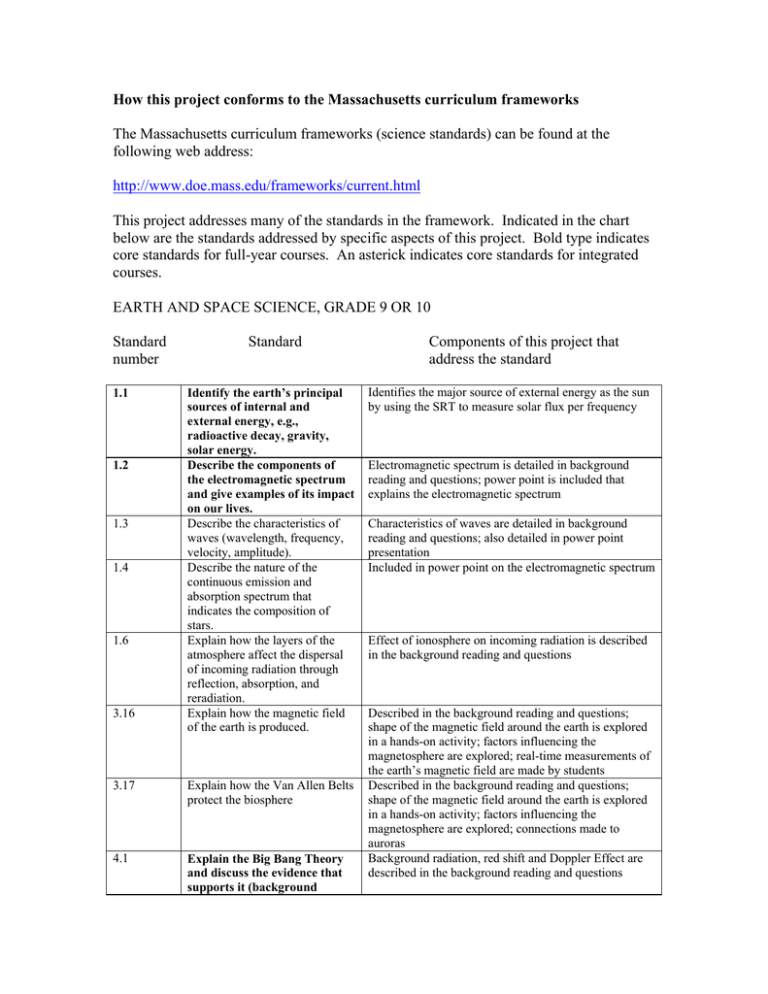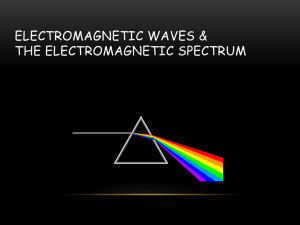How this project conforms to the Massachusetts curriculum frameworks
advertisement

How this project conforms to the Massachusetts curriculum frameworks The Massachusetts curriculum frameworks (science standards) can be found at the following web address: http://www.doe.mass.edu/frameworks/current.html This project addresses many of the standards in the framework. Indicated in the chart below are the standards addressed by specific aspects of this project. Bold type indicates core standards for full-year courses. An asterick indicates core standards for integrated courses. EARTH AND SPACE SCIENCE, GRADE 9 OR 10 Standard number 1.1 1.2 1.3 1.4 1.6 3.16 Standard Identify the earth’s principal sources of internal and external energy, e.g., radioactive decay, gravity, solar energy. Describe the components of the electromagnetic spectrum and give examples of its impact on our lives. Describe the characteristics of waves (wavelength, frequency, velocity, amplitude). Describe the nature of the continuous emission and absorption spectrum that indicates the composition of stars. Explain how the layers of the atmosphere affect the dispersal of incoming radiation through reflection, absorption, and reradiation. Explain how the magnetic field of the earth is produced. 3.17 Explain how the Van Allen Belts protect the biosphere 4.1 Explain the Big Bang Theory and discuss the evidence that supports it (background Components of this project that address the standard Identifies the major source of external energy as the sun by using the SRT to measure solar flux per frequency Electromagnetic spectrum is detailed in background reading and questions; power point is included that explains the electromagnetic spectrum Characteristics of waves are detailed in background reading and questions; also detailed in power point presentation Included in power point on the electromagnetic spectrum Effect of ionosphere on incoming radiation is described in the background reading and questions Described in the background reading and questions; shape of the magnetic field around the earth is explored in a hands-on activity; factors influencing the magnetosphere are explored; real-time measurements of the earth’s magnetic field are made by students Described in the background reading and questions; shape of the magnetic field around the earth is explored in a hands-on activity; factors influencing the magnetosphere are explored; connections made to auroras Background radiation, red shift and Doppler Effect are described in the background reading and questions 4.7 radiation, and Relativistic Doppler effect ~ red shift). Compare and contrast the various instrumentation used to study deep space and the solar system, e.g., refracting telescope, reflecting telescope, radio telescope, spectrophotometer. Described in the background reading and questions; detailed in the power point presentation; students make their own ground-based measurements with the sunspotter, magnetometer, and SRT CHEMISTRY, GRADE 10 OR 11 Standard number 1.3 2.5 2.6 Standard Describe the four states of matter (solid, liquid, gas, plasma) in terms of energy, particle motion, and phase transitions.* Using Bohr’s model of the atom interpret changes (emission/absorption) in electron energies in the hydrogen atom corresponding to emission transitions between quantum levels. Describe the electromagnetic spectrum in terms of wavelength and energy; identify regions of the electromagnetic spectrum. Components of this project that address the standard Four states of matter are briefly described in the background reading and questions; focus is on plasmas Neutral hydrogen emission caused by the spin-flip of the electron is described in the background reading and questions Electromagnetic spectrum is detailed in background reading and questions; power point is included on the electromagnetic spectrum PHYSICS, GRADE 9 OR 10 Standard number 3.4 4.2 4.4 Standard Recognize that matter exists in four phases, and explain what happens during a phase change. Recognize the measurable properties of waves (e.g., velocity, frequency, wavelength) and explain the relationships among them. * Distinguish between mechanical and Components of this project that address the standard Four states of matter are briefly described in the background reading and questions; focus is on plasmas Characteristics of waves are detailed in background reading and questions; also detailed in power point Difference is briefly described in background reading and questions 4.6 6.1 6.2 6.4 electromagnetic waves. * Recognize the effects of polarization, wave interaction, and the Doppler effect. Describe the electromagnetic spectrum in terms of wavelength and energy, and be able to identify specific regions such as visible light. * Explain how the various wavelengths in the electromagnetic spectrum have many useful applications such as radio, television, microwave appliances, and cellular telephones. Recognize and explain the ways in which the direction of visible light can be changed. Doppler effect is described in the background reading and questions Described in the background reading and questions; detailed in a power point presentation Described in the background reading and questions; detailed in a power point presentation; students will study the applications of radio waves by using a SRT Reflection is explained in the background reading and questions and in a power point presentation; students participate in a hands-on activity to determine the focal point of an antenna; reflected light is used to make measurements with the magnetometer TECHNOLOGY/ENGINEERING, GRADE 9 OR 10 Standard number 6.1 6.2 6.3 6.4 Standard Identify and explain the applications of light in communications, e.g., reflection, refraction, additive, and subtractive color theory. Explain how information travels through different media, e.g., electrical wire, optical fiber, air, space. Compare the difference between digital and analog communication devices. Explain the components of a communication system, i.e., source, encoder, transmitter, receiver, decoder, storage, retrieval, and destination. Components of this project that address the standard Reflection explained with respect to collection dishes in the background reading and power point presentation; students participate in a hands-on activity to determine the focal point of an antenna Signals traveling through air is explained in the background reading and power point presentation Difference between digital and analog signals is explained in a power point presentation Receiver dishes are explained in the background reading and power point presentation; students participate in a hands-on activity to determine the focal point of an antenna Skills of inquiry In addition, this project allows teachers to address significantly all of the skills of inquiry detailed in the Massachusetts Curriculum Frameworks with the exception of the fourth skill. The high school skills of inquiry are listed below: 1) Pose questions and state hypotheses based on prior scientific observations, experiments, and knowledge. 2) Distinguish between hypothesis and theory as scientific terms. 3) Either individually or as part of a student team, design and complete a scientific experiment that extends over several days or weeks. 4) Use mathematics to analyze and support findings and to model conclusions. 5) Simulate physical processes or phenomena using different kinds of representations. 6) Identify possible reasons for inconsistent results, such as sources of error or uncontrolled conditions. 7) Revise scientific models. 8) Communicate and defend a scientific argument.




